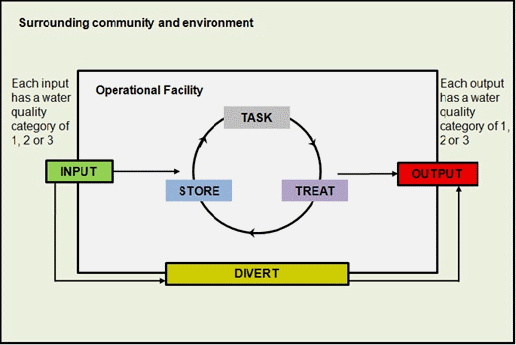Capacity Building of the Minerals Council of Australia Water Accounting Framework
The minerals industry has recognised the importance of sustainable water management policies and practices, with major companies reporting on their water performance on an annual basis. Historically companies have used different definitions and methodologies to capture their water performance, making cross-company comparisons and communication invalid. The Minerals Council of Australia Water Accounting Framework (WAF), co-developed by the Centre for Water in the Minerals Industry (CWiMI), is a standard methodology to represent, record and communicate a site’s water performance thereby, allowing for valid comparisons between companies and transparent communication of water performance, contributing towards the preservation of a social licence to operate.
The WAF is concerned with (1) the reporting of inputs and outputs by source/destination and quality, encapsulated in an Input-Output Model; and (2) the reporting of water use and reuse efficiency in activities internal to operations, such as ore processing and dust suppression, encapsulated in the Operational Model. Since 2005, the WAF has been tested with over sixty mine sites across four continents and on a number of commodities including: coal, copper, gold, iron ore and diamonds, demonstrating its flexibility and robustness. In 2011, the MCA endorsed the adoption of the Input-Output Model by its members, requiring them to align company metrics and reporting to be consistent with the Input-Output Model. In addition some companies decided to align metrics to the WAF globally.
CWiMI can facilitate capacity building workshops to help the industry to implement the WAF. The workshops teach participants a foundation of the WAF and how to develop their own water accounts. Since 2010, over 200 industry professionals have attended our workshops.

Following completion of the capacity building workshops delegates will have:
1. An understanding of the background to, and motivation of the MCA Water Accounting Framework;
2. An understanding of how to design a “whole of site” water system representation including its key components (inputs, outputs, diversions, tasks, stores, treatments);
3. The ability to understand the current level of accuracy of a water system and to identify gaps;
4. The capability to produce reports in accordance with the described MCA definitions.
5. An understanding of the issue of mixing raw and worked water and how it can impact on the calculation of operational efficiency (reuse and recycling).
6. A better understanding of how the WAF can help your company report to other reporting frameworks such as Global Reporting Indicators (GRIs) and Australian Water Accounting Standard (AWAS).
Workshop Structure
We offer a range of workshops that can be tailored according to the needs of stakeholders.
- General Capacity Building Workshop – Where we present the WAF and facilitate participants working in groups to develop a water account from scratch using a synthetic data set. This workshop is aimed a diverse audience including operational level personnel, site level management, corporate level management, regulators and consultants. This course is suitable for companies that want their members to gain an understanding of the WAF, without the expense of a dedicated workshop.
- Company Specific Capacity Building Workshop – The workshop material can be tailored to a company’s needs. We can discuss the terms the company currently uses and how these translate to the WAF terminology. We facilitate participants working in small groups to either develop accounts for their own sites or from a synthetic data set. This workshop is usually aimed at an audience that includes operational level personnel and site level management. This course is suitable for companies that want a large number of members to gain an understanding of the WAF.
- Site Specific Capacity Building Workshop –This material is more specific than Workshop 2 as the workshop material can be tailored to the site’s needs. We facilitate a small group of participants working together to develop an account for the site in question and identify current information gaps. In doing so, it makes it easier for personnel to continue developing their own accounts. This workshop is usually aimed at an audience of operational level personnel. This course is suitable for companies that want to produce a water account for a single site.
References
N. Danoucaras and A. Woodley, Corporate Sustainability Reporting for Water: Water Footprint, Global Reporting Initiative and the Water Accounting Framework, 6th International Conference on Sustainable Development in the Minerals Industry, 30 June – 3 July 2013, Milos Island, Greece, 2013
A. Woodley, A Comparison of Three Models for Mine Water Management, Water in Mining 2012. Proceedings of the 3rd International Conference on Water Management in the Mining Industry, 6 - 8 June 2012 (Fernando Valenzuela and Jacques Wiertz), Gecamin, 2012.
C.M. Cote, C.J. Moran, O.J. Acosta. 2010. Progressing Towards Sustainability: From Water Efficiency to Water Effectiveness at the Collahuasi Mine. Water in Mining 2010. Santiago, Chile: 33-46.
C.M. Cote, C. J. Moran, C.J. Hedemann, C. Koch. 2010. Systems Modelling For Effective Mine Water Management.Environmental Modelling and Software 25 (12): 1664-1671.
C.M. Cote, C.J. Moran. 2009. A Water Accounting Framework for the Australian Minerals Industry. SDIMI09. Gold Coast, Australia 5:339-350.
C.M. Cote, C.J. Moran, J. Cummings, K. Ringwood. 2009. Developing a Water Accounting Framework for the Australian Minerals Industry. Water In Mining 2009. Perth, Australia 8:191-204.
C.M. Cote, C.J. Moran, C.J. Hedemann. 2007. Evaluating the costs and benefits of mine sites salt management strategies using a systems model. Mine Water and the Environment 26(4): 229-236.
C.M. Cote, C.J. Moran, C.J. Hedemann, A.H. Davis, N. Silvester, C. Koch, C.P.D. Tollari. 2006. Systems Modelling for Water Management in Mining and Minerals - Bowen Basin Coal. Water in Mining Conference Proceedings. Carlton, Australia 10: 215-223.
